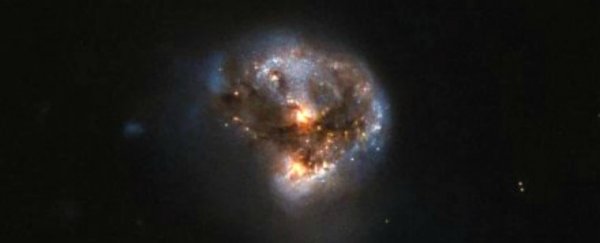To send 2016 off properly, Hubble has captured the most detailed image to date of the mysterious galaxy IRAS 16399-0937, which acts as a giant, astronomical laser.
But it's not your standard laser. Instead of blasting out visible light, the galaxy pumps out an intense and constant stream of microwave radiation. "This galaxy has a far more exciting and futuristic classification than most - it hosts a megamaser," explains NASA (microwave + laser = maser).
Masers are found throughout the Universe, wherever molecular clouds of dust amplify any microwave radiation that passes through, enhancing and focussing the amount that's emitted on the other side.
There are even some masers in our own galaxy, but megamaser IRAS 16399-0937 is a lot brighter - 100 million times brighter, to be specific, and almost the entire galaxy acts as a maser, rather than just one or two molecular clouds.
Megamasers are around 100 million times brighter than the masers found in galaxies like our own Milky Way!
— Hubble (@NASAHubble) December 29, 2016
READ: https://t.co/U27Nuh4w4b pic.twitter.com/EYSyrAhmh8
Although scientists have long known about the galaxy, which is located 370 million light-years away from Earth, this is the most detailed look at its internal structure to date. And don't be fooled by how serene the image above looks, in reality, IRAS 16399-0937 is actually a galaxy in turmoil.
The image was taken across a range of wavelengths by two of Hubble's instruments: the Advanced Camera for Surveys, and the Near Infrared Camera and Multi-Object Spectrometer, and it reveals that the galaxy actually has a double nucleus.
That means that the galaxy formed as a result of two galaxies smashing into each other, and those two cores are still in the process of merging.
You can see these two bright cores glowing orange in the image above. And although the whole system looks pretty tight, the two cores sit more than 11,000 light-years apart. For perspective, the closest neighbouring star to Earth is 4.3 light-years away.
The two galactic cores also appear to be very different. The northern one has been named IRAS 16399N, and the southern core is IRAS 16399S. While IRAS 16399S appears to be a hugely active starburst region, with new stars being born at an enormous rate, the northern core is pretty much the opposite, with just a huge field of weakly-ionised neutral gas.
But IRAS 16399N does contain something noteworthy - the Hubble image reveals an enormous black hole that's 100 million times the mass of the Sun.
If you want a little perspective on just how big that is, check out the video below, and prepare to have your mind crushed.
We can't wait to see what space has in store for us in 2017.
